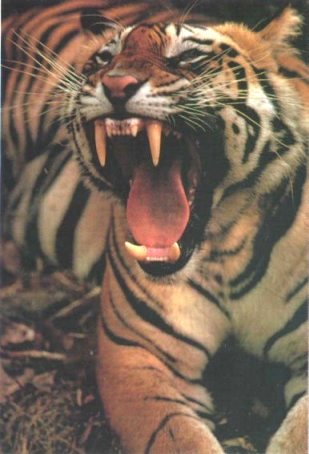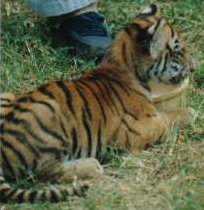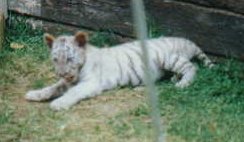 The Bengal Tiger
The Bengal Tiger

ORDER FAMILY GENUS & SPECIES
CARNIVORA FELIDAE PANTHERA TIGRIS TIGRIS
KEY FEATURES
- Solitary cat that kills by stealth and ambush.
- Can kill a buffalo weighing more than 2,000 lbs.-nearly four times its own weight.
- Most water-loving of the big cats: it will even chase prey into water.
- Kills with a deadly bite to the throat using long canine teeth.
WHERE IN THE WORLD!
Isolated populations found across India, but most numerous in the mangrove swamps of the Sundarbans region that lies in Bangladesh and northwestern West Bengal: scattered populations in Nepal, Bhutan and Burma.

PROFILE
The tiger's powerful muscles and massive build are key to its hunting success: in seconds, it can kill prey that weighs nearly double its weight.
EYES
- The tiger's night vision is six times better and ours. A mirror-like layer at the back of the eye reflects extra light.
EARS
- Hearing is the tiger's sharpest sense. White spots behind the ears help the tigers identify one another in the jungle.
COAT
- Every tiger has a unique pattern of black stripes on an orange coat. This breaks up the body's outline in dense cover.
TEETH
- Long canine teeth are used to stab and kill prey. Molars behind them act like scissors, slicing strips of flesh from a carcass.
CLAWS
- Claws are used to grip prey and scratch trees. They retract when the tiger walks to remain sharp and allow it to stalk prey silently.
VITAL STATISTICS
Weight 396-583lbs
Length
Head/Body 6.3-7.3'
Tail 32-36"
Shoulder 36-38"
Height
Sexual Female 3-4
Maturity years;Male
4-5 years
Mating Winter to
Season spring
Gestation 95-112 days
Period
Number 2-4
of Young
Typical Sambar deer,
Diet chital deer,
water buffalo, guar,
wild pigs,
and monkeys
Lifespan Up to 26 years
in the wild
HABITAT
The Bengal tiger adapts to the enviroment, as much at home in the cold forest of the Himalayas as it is in the warm, humid mangrove swamps of the Sundarbans region that straddles northeastern Bangledesh. An excellent swimmer, the tiger is also the most water-loving of the big cats. It can often be found near slow-flowing rivers and shady pools, where it can ambush prey or simply cool off during the heat of the day.
The tiger always occupies a home range that is dense in vegetation. Largest territories are held by the male tigers and may cover an area up to 40 square miles. A large range allows the tiger to find plenty of food, while good cover helps it stalk its prey unseen.
BREEDING
The Bengal tiger usually breeds in the spring when the female becomes fertile for three to seven days. After mating, the male and female remain together for a few days. The male then leaves the female and plays no further part in the rearing of the cubs.
About 15 weeks later, two to four cubs are born. Tiger cubs are suckled for up to six months, although the mother starts to bring them small prey from the age of six weeks. Once weaned, the cubs join their mother hunting to learn skills they will need to survive on their own. By the age of 18 months, the cubs are able to feed themselves.
BEHAVIOR
Although reputed to be fiercely solitary, the Bengal tiger simply needs alot of space to hunt and therefore is social at a distance. In fact, a male's territory usually overlaps those of several females.
The tiger visits most of its territory within the space of a few days and marks its boundaries by shredding the bark of trees with its claws. Then it sprays these "signposts" with a strong smelling urine. The urine not ony reinforces the boundry markings, but also sends highly complex chemical messages to other tigers, including the owner's sex sixe, social status and (for females) breeding status. These messages are essential to tiger society; they help the tigers avoid competition for food, as well as conflicts over territory.
FOOD & HUNTING
The tiger can kill prey large enough for several meals. After a kill, the tiger drags or carries its victim out of sight to feed. The tiger usually begins with the hindquarters, but will eventually eat almost every part of its prey, including the skin and the hair, which helps with digestion. The tiger can eat up to 66 lbs. of meat at one time and once it has eaten its fill, it covers the remains of it prey with leaves, returning to the carcass each night until it is finshed. Like most big cats, it will even eat meat that has begun to rot.
DID YOU KNOW
White tigers are not a seperate species, but the result of genetic mutation.
- The Bengal tiger often walks backward into the water to keep a watchful eye on its surroundings.
AND NOW MY FINAL THOUGHT
The pictures below were taken a few years back at the Knoxville Zoo where I had a chance to get upclose and personal with these Tiger Cubs. At the time they were just 3 months old and were playful cats. Hard to believe that within a year they would be hunting on there own if they were in the wild.
Or because of the value of their skins and other body parts they may have been killed. We as people must stop this from happening. If not the Tiger as we know it will become extinct. Can we handle telling our kids or grandkids that we were responsible for the extinction of the Tiger. I sure hope that this doesn't happen.
Let nature take its course without the human element becoming involved.



Excuse me you dont have a Geocities Account? Why bother with the others when Geocities is all you need and its FREE
 Get Your OwnFree Home Page
Get Your OwnFree Home Page




